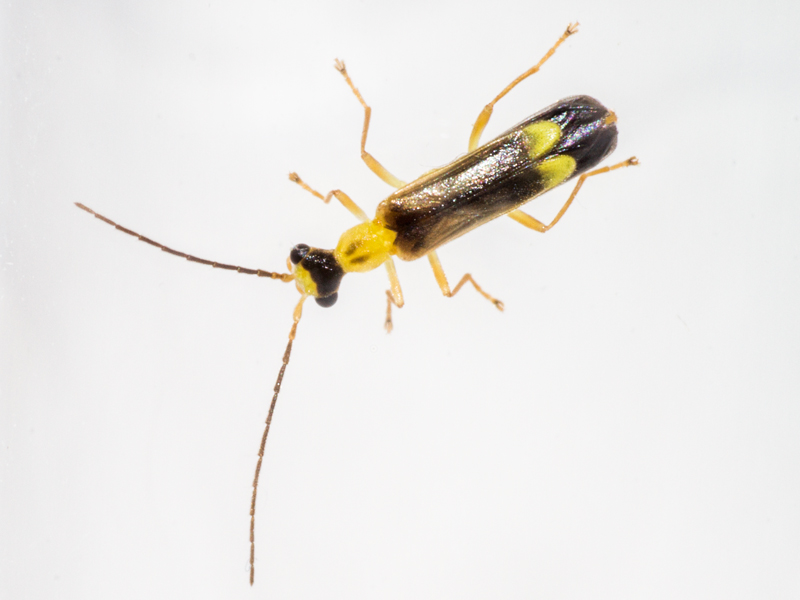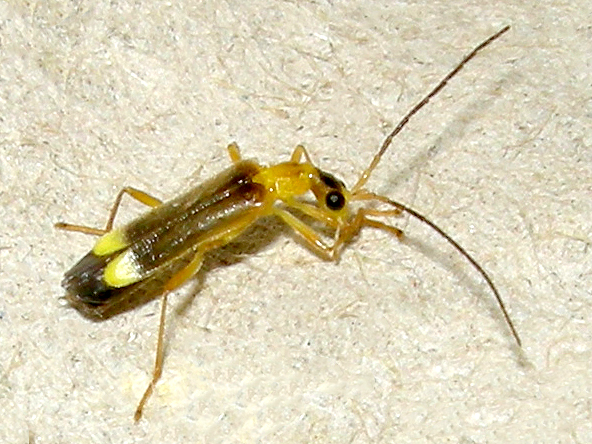Malthinus flaveolus
This is one of those species that isn't too hard to identify unless you look too hard, and then it can become confusing, depending on what references you're using. The first few I identified, probably using Hackston's key, seemed fairly straightforward so far as I recall, but later using both Duff and Hackston and a better microscope, I encountered some problems. The main issue is that contrary to the keys, flaveolus can have some punctures along some of its elytral striae - scroll down for details.

Malthinus flaveolus, North Elmham Cathedaral Meadows (Norfolk, UK), 30th June 2019
 (1).jpg)
Malthinus flaveolus, North Elmham Cathedaral Meadows (Norfolk, UK), 24th June 2019

Malthinus flaveolus, North Elmham Cathedaral Meadows (Norfolk, UK), 2nd July 2021
 (2).jpg)
 (1).jpg)
Malthinus flaveolus, North Elmham (Norfolk, UK), 14th July 2023

Malthinus flaveolus, North Elmham (Norfolk, UK), 18th June 2019
 (1).JPG)
 (2).JPG)
Malthinus flaveolus, North Elmham (Norfolk, UK), 13th June 2018
The following one was where I hit a problem. The main character differentiating this species from Malthinus flaveolus is whether or not the striae on the elytra are punctured. On this individual the majority of striae seemed to lack punctures except at the very base, and some even there. Mike Hackston's key suggests that flaveolus can have elytral punctures but never in the furrows, whereas seriepunctatus (and balteatus) have "rows of punctures". The latter implies to me a bit more than I could see on this individual, but the presence of any rows of punctures, even short rows, appeared to eliminate flaveolus. Duff's key words the difference slightly differently which allows for a slightly different interpretation. Duff says seriepunctatus (and balteatus) should have "well-marked punctate striae" whereas the striae are "obsolete" on flaveolus. That word "obsolete" is never entirely clear to me - does it mean that they're effectively non-existent (in which case wouldn't it be clearer to say that?), or that they're merely very indistinct? In either case, if I was describing my individual I would say the striae somewhere in between well-marked and obsolete - present if looked for carefully but quite overlookable otherwise. The first stria next to the suture was distinct and clearly punctured, and a couple of the other striae were clearly punctured for short or very short distances near the base, so I thought based on both keys seriepunctatus was the best fit on this character. At the time I didn't have any specimens to compare.
Given the difficulty in seeing the punctured striae it would be helpful if the keys had further characters to check. I noticed after looking at a load of photos of both species online the only ones showing a pair of longitudinal markings on the pronotum were all flaveolus. But I wasn't sure if this was significant as neither key describe any differences in the shape of the dark mark between the two species, with Duff describing both species' pronotum as yellow with a more or less extensive black (flaveolus) or dark (seriepunctatus) discal mark. Hackston gives a size range for flaveolus but not for seriepunctatus, but mine was smaller than the range given for flaveolus. Duff does give ranges for both and in doing so confirms that seriepunctatus averages smaller, with mine being comfortably within range for that and well below the range for flaveolus. So with size as a supporting character I was leaning towards labelling this one as seriepunctatus... until I looked at its genitalia.
Duff doesn't cover the genitalia for these species at all, but Hackston includes a comparison of male genitalia between seriepunctatus and balteatus - but doesn't show flaveolus genitalia. My individual's genitalia didn't appear to match the picture of seriepunctatus shown in the Hackston key (nor the picture for balteatus). Hackston provides a link to one of his sources, a German key, and this does include photos of flaveolus genitalia (well, punctatus actually, but I think punctatus must be a synonym of flaveolus as flaveolus isn't covered in the key otherwise and the link provided for punctatus takes you to a page about flaveolus). This photo is a different view to the diagrams provided for seriepunctatus so not directly comparable, but I could not see any difference between the genitalia of my specimen and what the German key shows for flaveolus, and, as I couldn't match mine with the diagram of seriepunctatus genitalia, that strongly suggested that mine might in fact be flaveolus after all.
The German key also shows a side view of the last sternite and (assuming the sternite is the lower branch in the photo) it shows a deeply lobed edge (and although I don't understand German, putting the text through a translator I think this refers to the lobed edge too). My specimen was different - there was no indentation between the lobe and the tip. The key doesn't provide an equivalent photo of the last sternite of seriepunctatus, so I didn't know if that fitted mine any better. So, I was left unsure if mine was a small, well-punctured flaveolus with a differently-shaped last sternite to the one in the German key, or if I was looking at the genital capsule in the wrong orientation/focus to be able to see the likeness to the diagram for seriepunctatus genitalia.
Eventually in 2024 I was able to clear the matter up firmly after reviewing all my Malthinus records and outstanding specimens. Firstly I now had a specimen of seriepunctatus and the striae were far more obviously and extensively punctured - very different indeed from the one I'd been struggling with. Secondly I stumbled across an identification aid at the NatureSpot website which outlined some other differences between the two species:
- The difference in pattern on the pronotum was well-explained, confirming what I had already noticed from perusing photos.
- The shape of the black on the head (more Y-shaped on seriepunctatus so the yellow/orange extends further back over the vertex) and the colour in front of this (yellow/orange on seriepunctatus and yellow on flaveolus. I had already noticed this too when examining my specimens, and based on mine plus some online photos I would add that it's uniformly yellow on flaveolus whereas it's orange on the vertex merging to white on the frons on seriepunctatus).
- Scutellum colour - uniform yellow on flaveolus but dark at the base on seriepunctatus.
, North Elmham, 26-Jun-20 (A) (1).jpg)
, North Elmham, 26-Jun-20 (A) (2).jpg)
, North Elmham, 26-Jun-20 (A) (3) annotated.jpg)
, North Elmham, 26-Jun-20 (A) (5).jpg)
, North Elmham, 26-Jun-20 (A) (6).jpg)
, North Elmham, 26-Jun-20 (A) (7).jpg)
, North Elmham, 26-Jun-20 (A) (8).jpg)
, North Elmham, 26-Jun-20 (A) (9).jpg)
, North Elmham, 26-Jun-20 (A) (10).jpg)
, North Elmham, 26-Jun-20 (A) (11).jpg)
, North Elmham, 26-Jun-20 (A) (12).jpg)
, North Elmham, 26-Jun-20 (A) (13).jpg)
, North Elmham, 26-Jun-20 (A) (14).jpg)
, North Elmham, 26-Jun-20 (A) (15).jpg)
male Malthinus flaveolus showing right elytra, genitalia (6 views) and last sternite and tergite (5 views), North Elmham (Norfolk, UK), 26th June 2020
A similar individual appeared in my trap the following night. This one appeared almost identical - small, well below the stated range for flaveolus, and sharing the same short double parallel-lines dark mark on the pronotum. The genitalia - and the last sternite - appear exactly the same too. Whatever the last one was, I was sure this must be the same. Yet there was a difference in the extent or form of elytral puncturing. On this one I could not make out anything that I would describe as a puncture - not the small round indentations that I expect to see for something described as a puncture. But the elytral striae are not smooth - they do have rows of indentations, it's just that I would characterise this surface structure more as wrinkles or ridges than punctures. A long way from the "well-marked punctate striae" that Duff describes for seriepunctatus.
I think if I had just examined this one and not the previous one I would have (correctly) identified it as a small flaveolus and left it at that, probably not even examining the genitalia. But with both individuals being small and both having a different shape to the last sternite than shown in the German key for flaveolus, I was not confident either way and decided I needed to examine further examples of this genus before I could unpick what's going on here. With that now done, I'm now content that this was another flaveolus.
, North Elmham, 27-Jun-20 (A) (1).jpg)
, North Elmham, 27-Jun-20 (A) (2).jpg)
, North Elmham, 27-Jun-20 (A) (4).jpg)
, North Elmham, 27-Jun-20 (A) (3).jpg)
male Malthinus flaveolus showing elytra, genitalia and last sternite and tergite, North Elmham (Norfolk, UK), 27th June 2020
Using Duff and Hackston alone I don't think it's possible to name these old records from the photos, but based on the characters given at NatureSpot, they can all be confirmed as flaveolus. Perhaps they were omitted from the keys because they are not considered wholly reliable (there is some minor variation in the shape of the marks on the pronotum for example, so I can believe they don't always work), but until and unless I'm advised otherwise, my working assumption is that if all the characters for one or other species are shown in combination then the identification is safe.

Malthinus flaveolus, Bawdeswell (Norfolk, UK), 28th June 2010
 (1).JPG)
 (2).JPG)
 (3).JPG)
 (4).JPG)
Malthinus flaveolus, North Elmham (Norfolk, UK), 22nd June 2015

Malthinus flaveolus, North Elmham (Norfolk, UK), 30th June 2016

Malthinus flaveolus, North Elmham (Norfolk, UK), 5th July 2015
